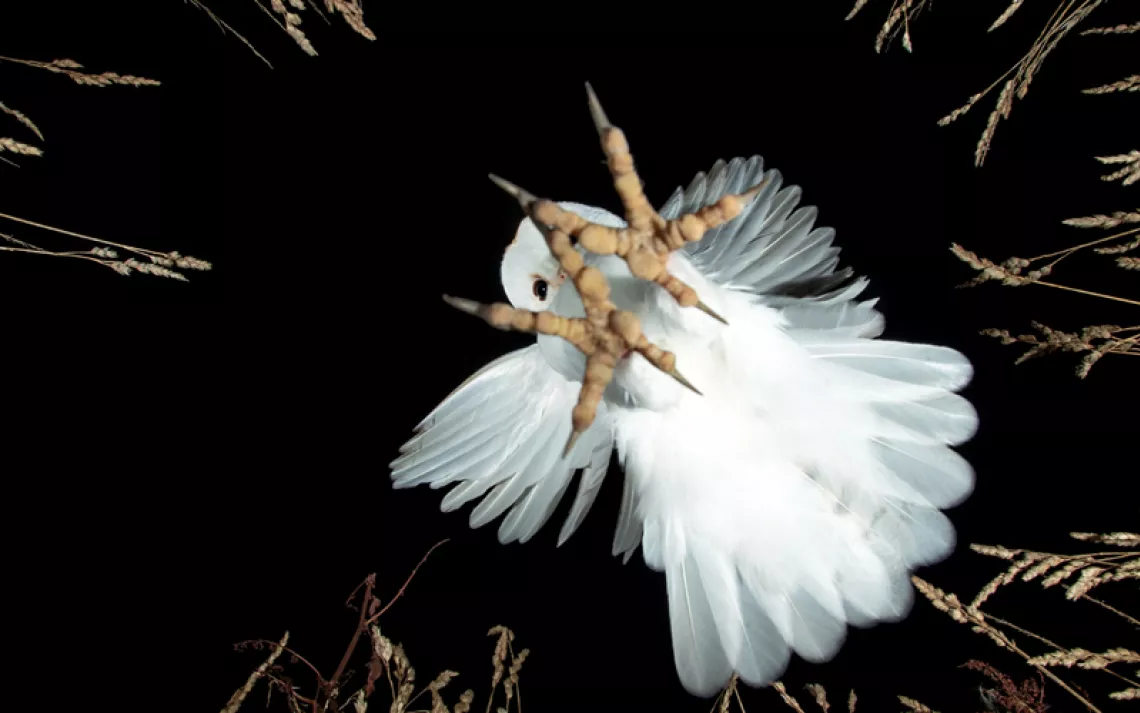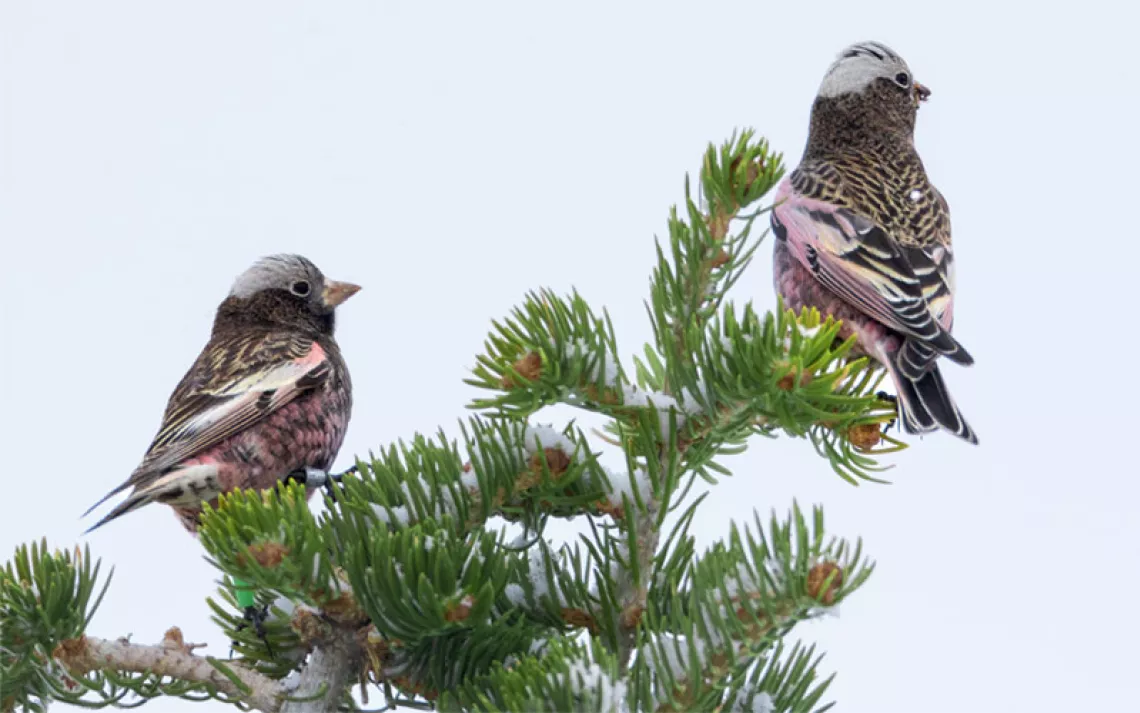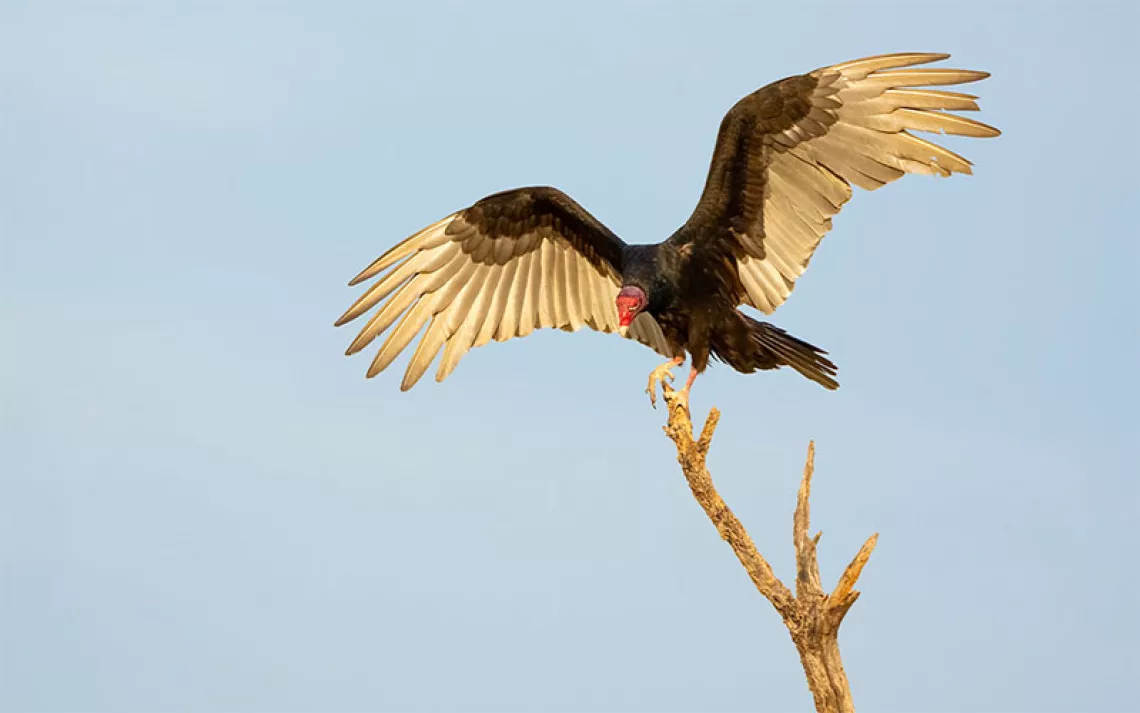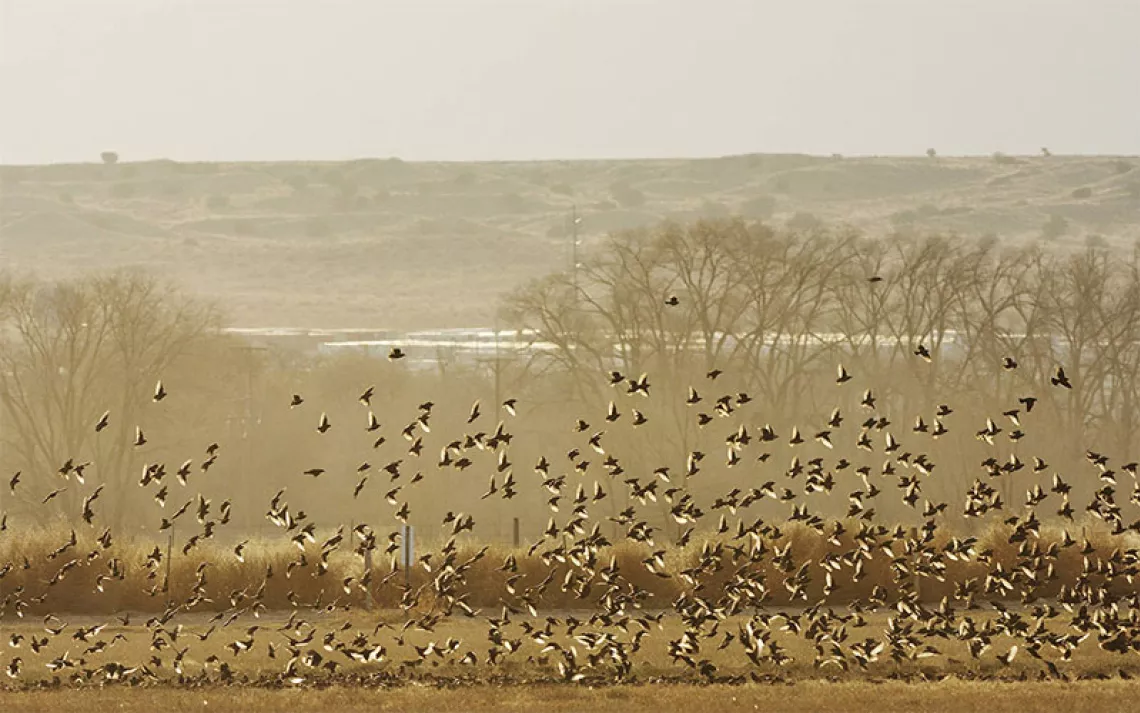Owl
A new book by photographer Paul Bannick captures intimate moments in the lives of owls
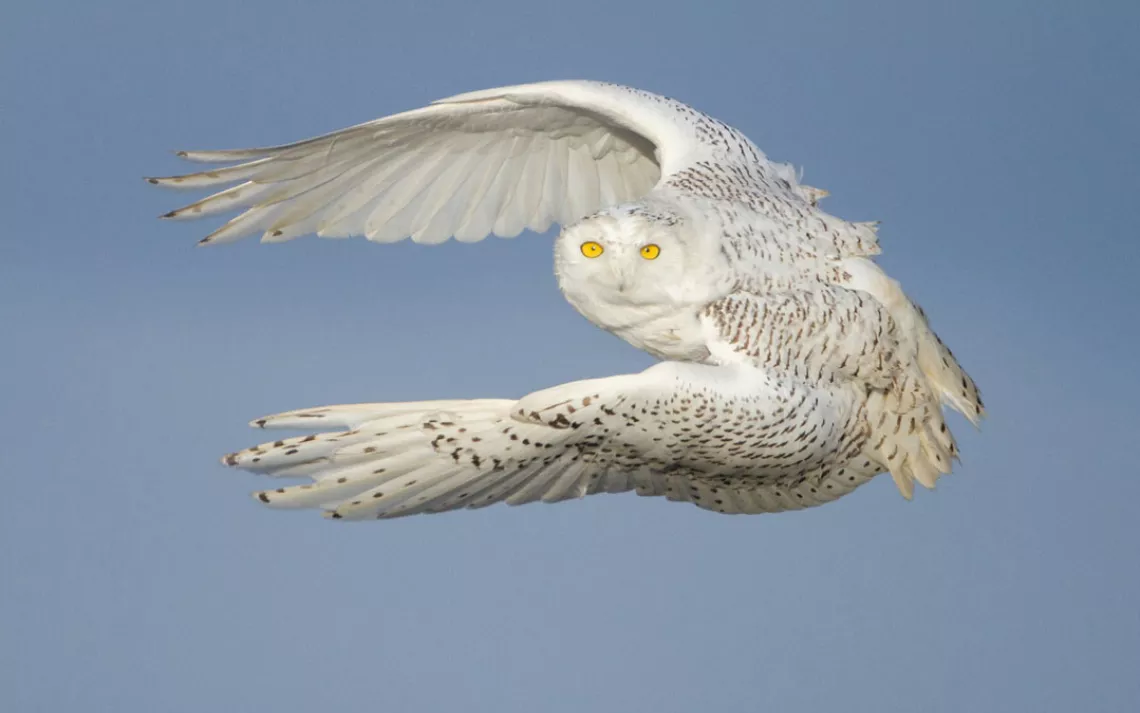
A snowy owl spots a vole in the grass nearby. | Photo by Paul Bannick
When photographer Paul Bannick was a young boy, he searched out the birds, amphibians, and small mammals in the Seattle suburb where he grew up. By the time he was 10, bulldozers were encroaching on some of his favorite habitats. Marshes were being drained. Woodlands were being cut down. The changes disturbed him, but when he tried to tell family members what was happening, no one listened. At that time, Bannick’s father worked in communications at Boeing and used a camera in his work. So Bannick decided to photograph his favorite wildlife. When he showed people his pictures, they started paying attention. “I realized that I had a tool that I could use to help get into people’s hearts about what was being lost,” Bannick says. “And that became my dream, to create books of conservation photography that motivated the protection of land and protection of species.”
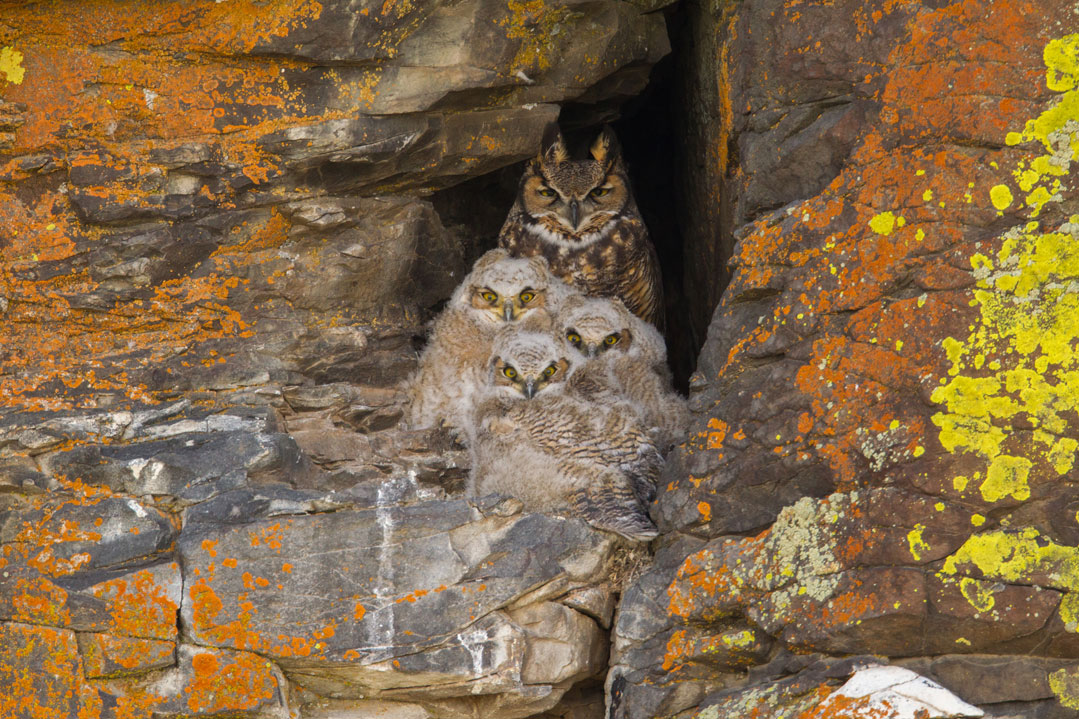
Great horned owls are highly adaptive and able to live in nearly every North American habitat. They occupy many types of nests, including cliff-face caves. | Photo by Paul Bannick
A decade ago, the Seattle-based lensman decided he wanted to photograph owls for a new book. In his first year, he found none. The second year, he found one—and kept looking. “And then it got to the point after about five years that I could find many North American species on most days because I knew where and when to look,” he says. “And a lot of where to look depends upon knowing the nuance of their habitat, knowing their life history, where they travel, how they travel, and where they are at various times of the year.”
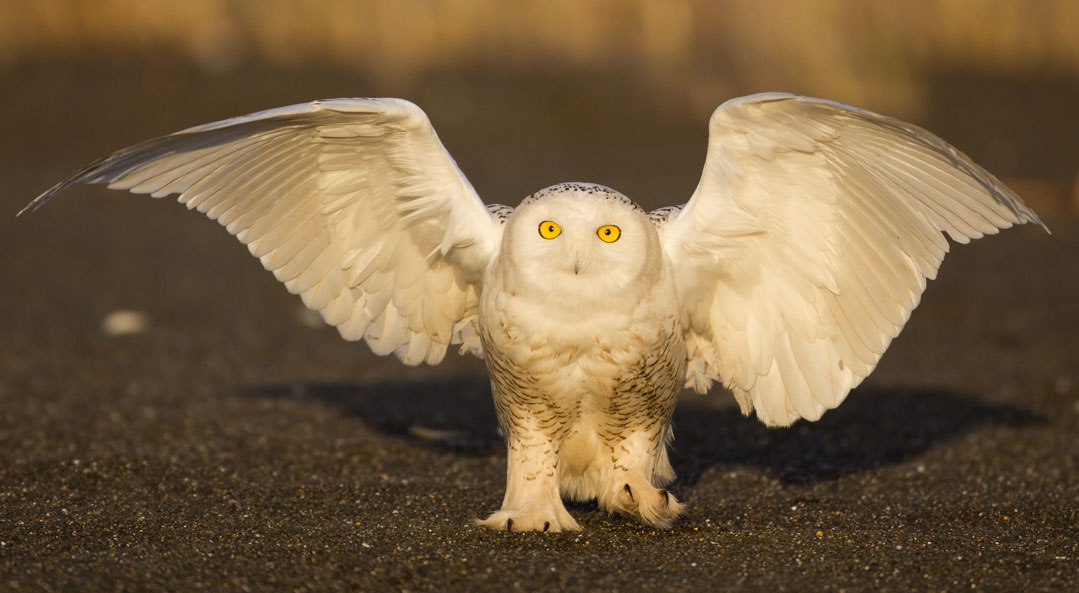
A snowy owl steps forward as it lands on a beach at sunrise. | Photo by Paul Bannick
When he started his quest, Bannick worked full time for an organization called Conservation Northwest. He spent every weekend, most evenings, and every vacation looking for owls. He estimates he spent several thousand hours a year doing this. After six years, he went to three-quarters time at work and spent three months of the year out in the field looking for owls.
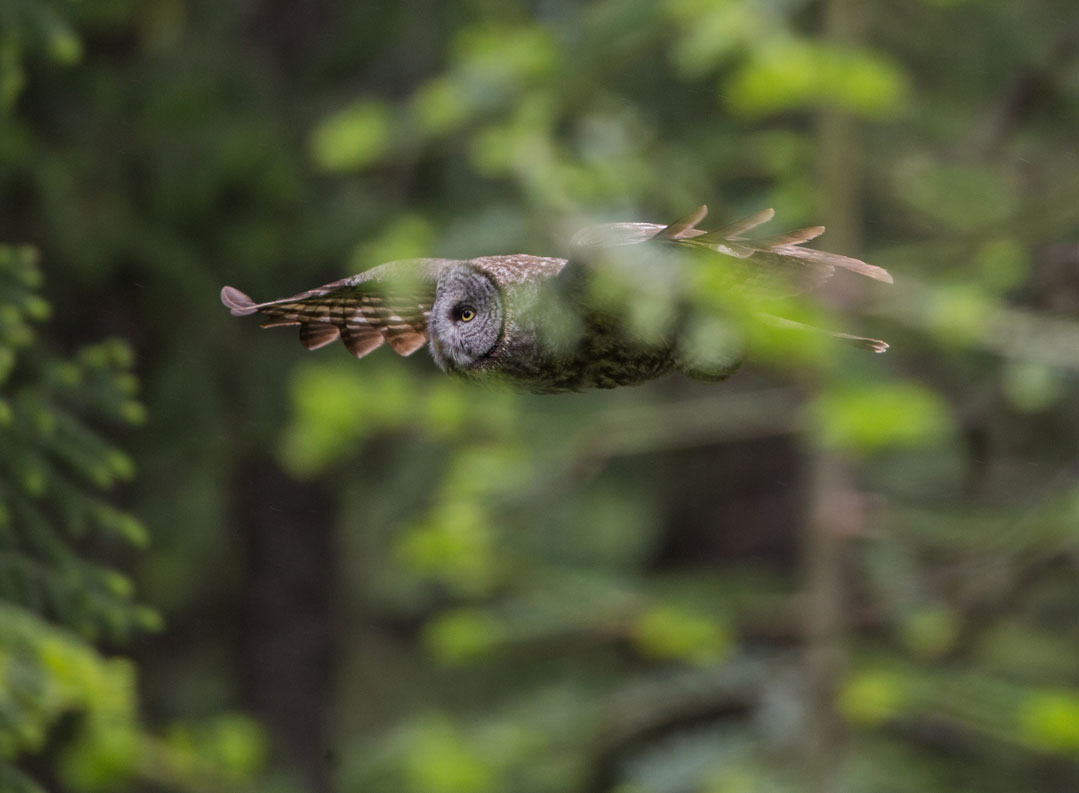
One of the largest owls in North America, the great gray owl can nonetheless disappear into tight spaces in its forest haunts, thanks in part to its very flexible wings and feathers. | Photo by Paul Bannick
To photograph different species, Bannick traveled from Florida to Ontario on the eastern seaboard. He traveled all over Canada. He went to Alaska and down to Arizona. He spent a lot of time in Texas, Colorado, Oregon, Idaho, and Montana.
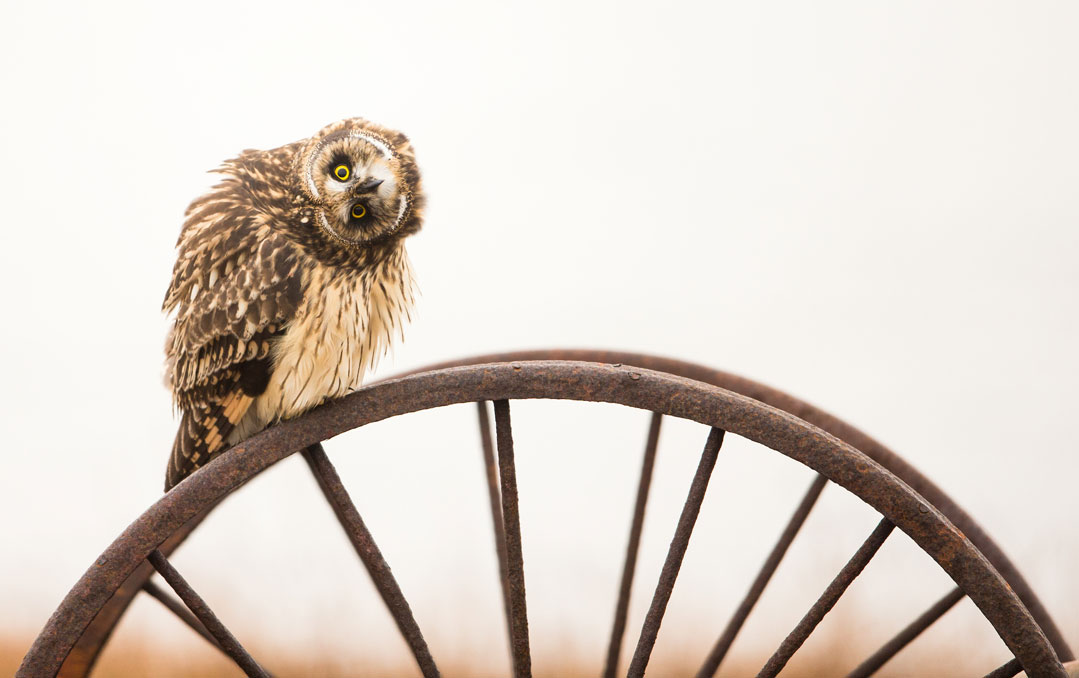
Short-eared owls in the Lower 48 require our thoughtful stewardship of their shrub-steppe and grassland habitats. | Photo by Paul Bannick
In each location, Bannick studied the owls’ behaviors. Then he set himself up to get the photos he wanted. He didn’t bait them to get photos. To photograph nocturnal owls, he arrived during the day and set himself up. With diurnal owls, he arrived at night and waited for the morning. He worked to get every key moment in an owl’s life, from courtship and nest selection to catching prey and feeding young, to young gaining their independence and surviving the winter weather. “I wanted to capture the full breadth of owl behavior, activity, and interrelationships with elements of habitat in the images that I have in the book,” he says.
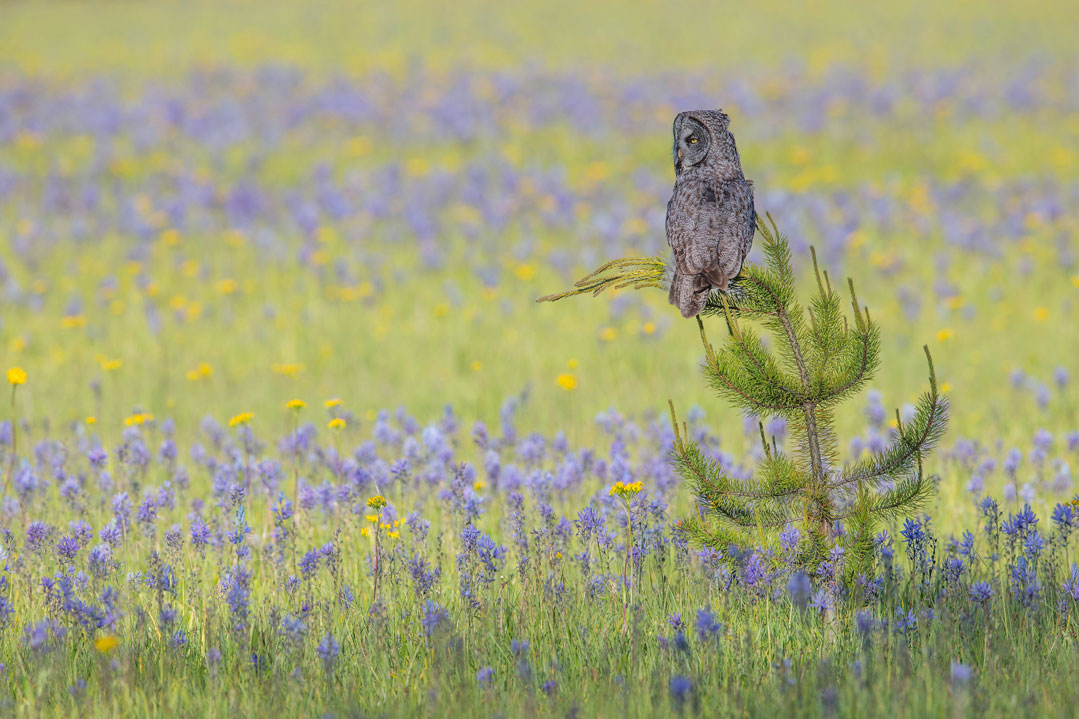
Great gray owls often listen for their prey from very low perches, like this lodgepole pine sapling. | Photo by Paul Bannick
There were plenty of tough shots. Bannick searched out cactus ferruginous pygmy owls, of which there are only a dozen pairs known to exist. He found a nest and watched four youngsters fledge. He searched out flammulated owls in a small ribbon of habitat in the western mountains of the United States, where they go after migrating from Central America. He captured them feeding at night on moths. On a rainy day in North Carolina, Bannick set his camera up in a hole in a tree and waited in a nearby blind to photograph eastern screech owls in their nest. On the Arctic tundra, he dressed up in camouflage and lay down on the ice in 50-mile-per-hour winds in order to capture snowy owls. “I’ve got some really compelling shots of their rarely photographed courtship,” he says. “Normally when you see it in books, there are just drawings of the courtship because people don’t have photographs of it.”
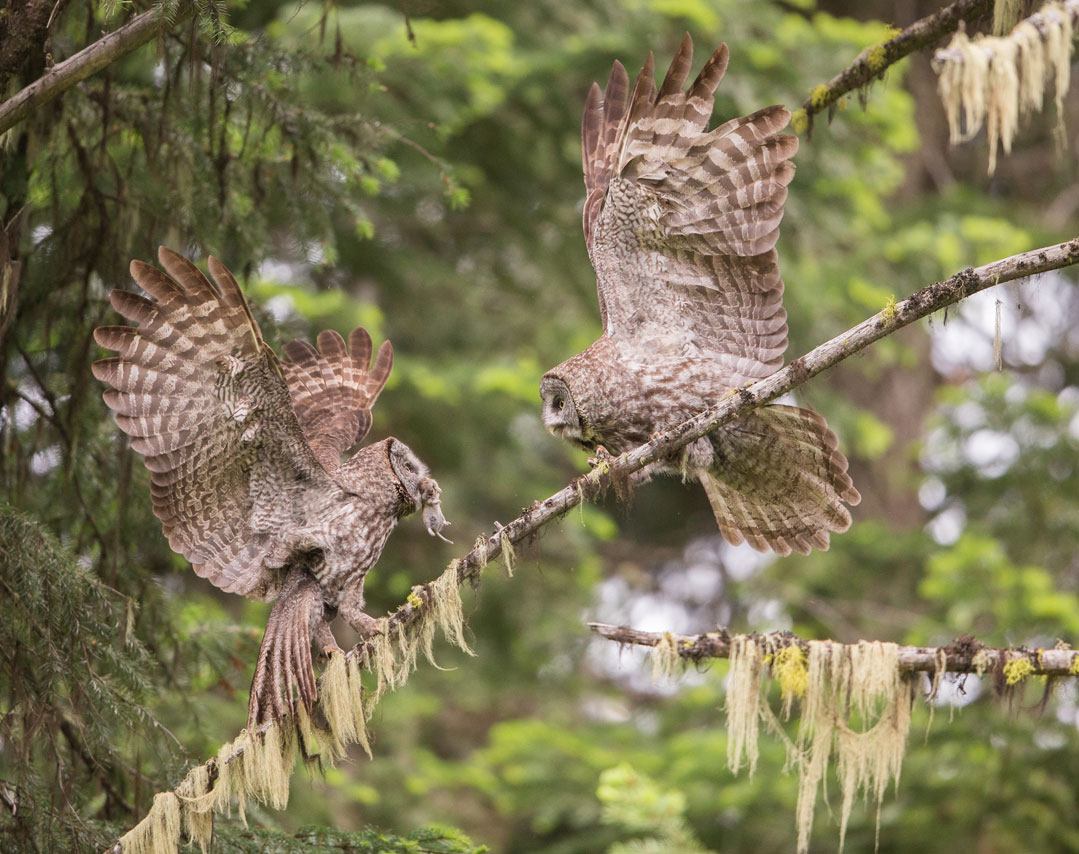
A male great gray owl delivers a gopher to his mate, who waits near the nest and nestlings. As with most species of owls, female great gray owls are significantly larger than males. | Photo by Paul Bannick
The shot that was the most rewarding took him the longest to get. He wanted to photograph young great gray owls jumping from the nest to take their first flight. Again and again he set up at nests to photograph this moment, but a deliberate leap just wouldn’t happen. He waited by nests in Alaska, Idaho, Washington, Wyoming, Alberta, and British Columbia with no luck. Young owls would often fall off the back of the nest, or an errant wing would knock them out of the tree. With three weeks left until the book closed, he found one last nest of great grey owls in Alaska and decided to wait by it. On the last day he had before the photography portion of the book closed, he got his shot. “Not only did I get one leaping from the nest, but I got three in a row leaping from the nest,” he says.
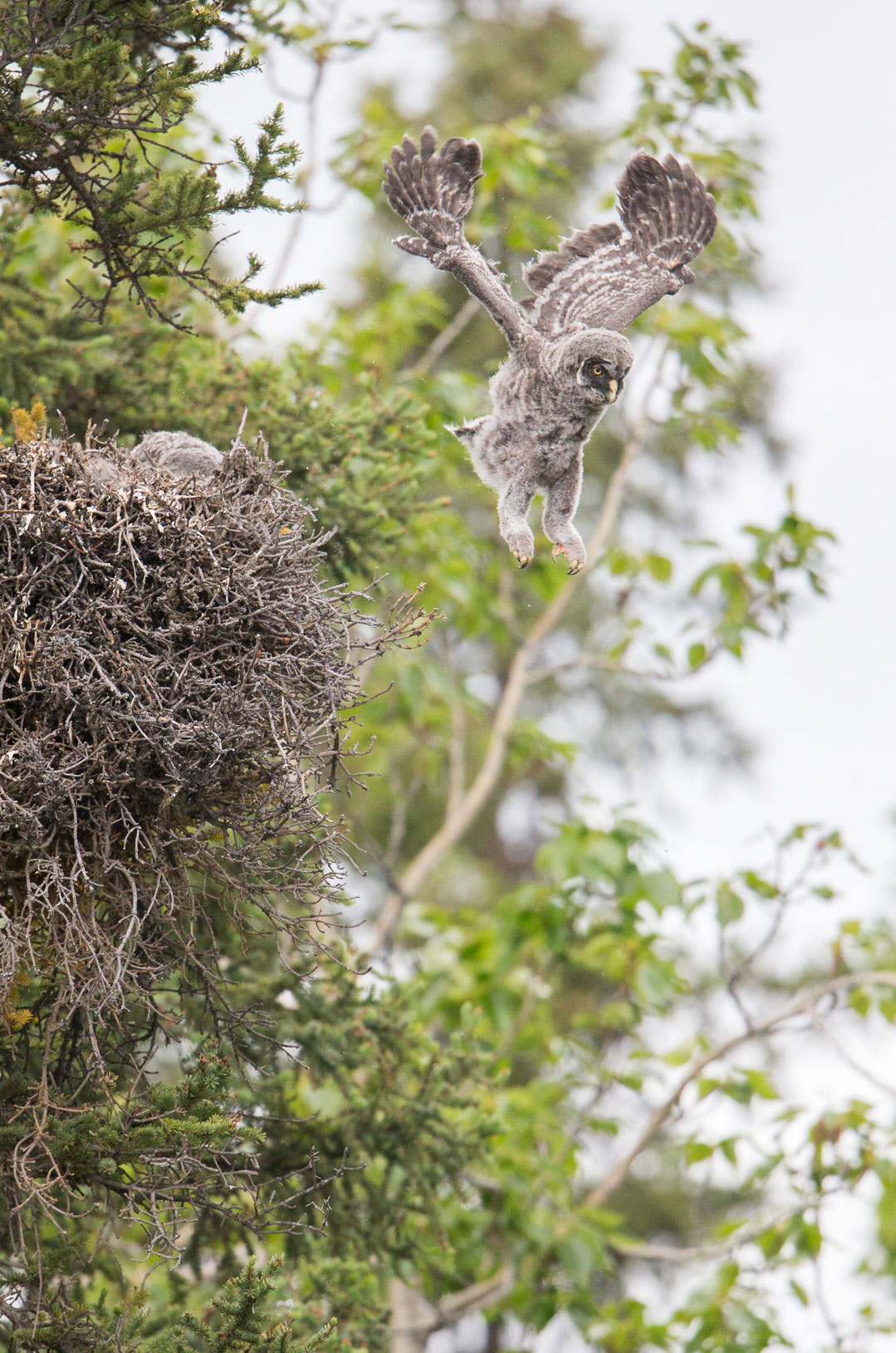
The first of three great gray owlets leaps from the nest. | Photo by Paul Bannick
Along the way of studying owls for this book, Bannick learned a lot about different species. One of the most important things he learned was how several species of owls could live in close proximity to agricultural lands while at the same time controlling rodents and insects perceived as pests. Different species need different habitat and prey. For example, short-eared owls that nest directly on the ground need patches of land where the grass isn’t grazed so the female on the nest and the vulnerable eggs and owlets can remain hidden by tall vegetation. Burrowing owls, on the other hand, prefer shorter grass that allows them to see predators in advance and can tolerate and even benefit from grazing, but farmers must retain prairie dogs, badgers, and other tunnel-digging animals, because the owls nest in their burrows. All rodent-eating owls suffer when powerful anti-coagulant rodenticides are used because they poison the owls.
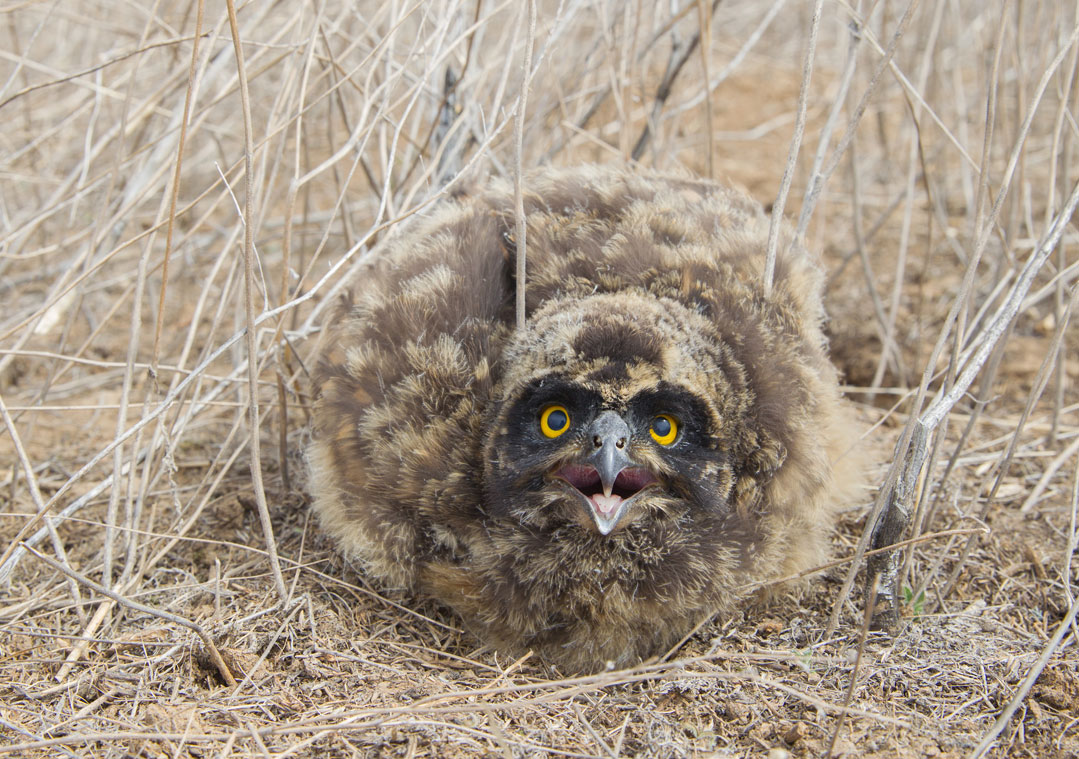
One at a time, short-eared owls begin leaving the nest, starting at about 12 days after hatching, and as much as two weeks before they can fly, making their camouflaged juvenal plumage very important. | Photo by Paul Bannick
Bannick hopes readers will learn the different requirements of owls in different habitats and at different times of the year when reading the book. “It’s remarkable that all 19 species that were here when Europeans first arrived still live today,” he says. “So we haven’t lost any yet, but there are a few on the brink.”
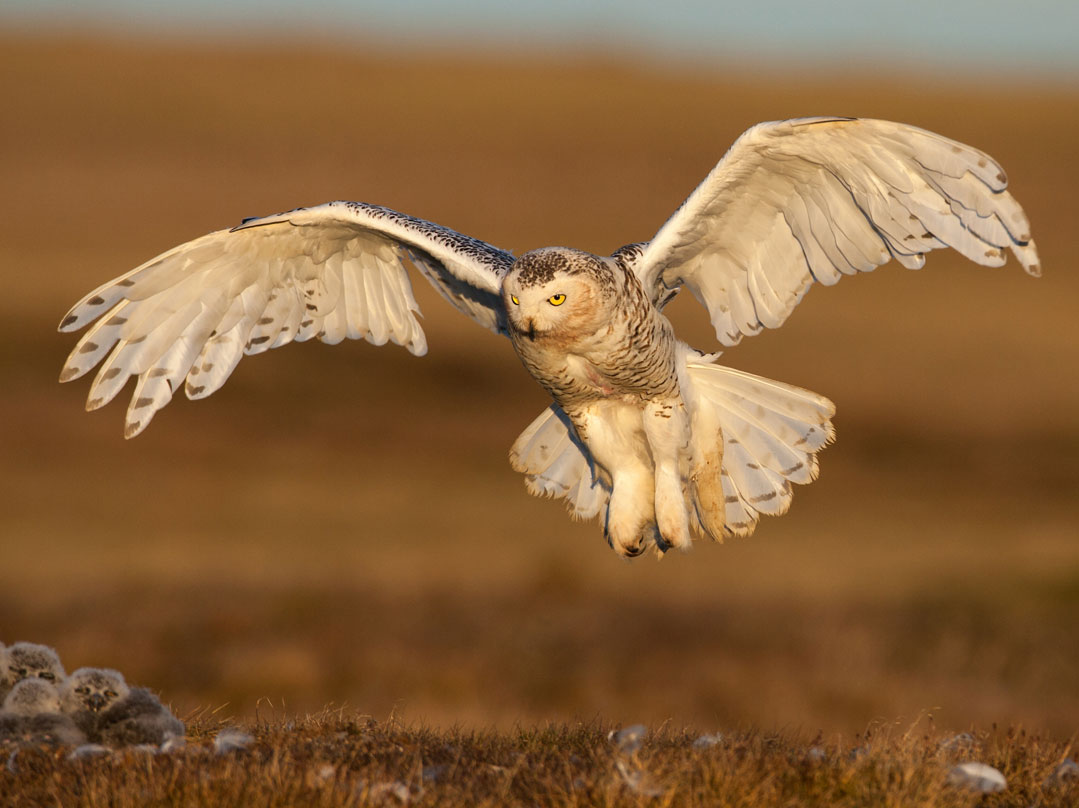
As she returns to her nest and young, a female snowy owl's brood patch, the temporary defeathered area of her stomach used to warm her eggs and young, is visible. | Photo by Paul Bannick
The book Owl (Braided River, October 2016) is organized so that people can learn about how different species live over the course of the year. In it, Bannick has captured the full range of behaviors exhibited by owls in all of their North American habitats. Though his pictures of owls have appeared in numerous other books and magazines, he has reserved his best photos for this book. He hopes people will come away from reading it with a goal to save owls and their habitats. “I believe that we protect what we love, and we love what we know,” he says. “So my ambition with the book is to have more people know owls.”
 The Magazine of The Sierra Club
The Magazine of The Sierra Club
